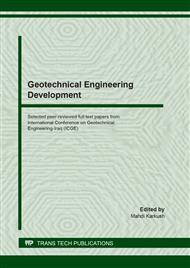p.349
p.358
p.367
p.374
p.383
p.394
p.399
p.409
p.417
Experimental and Statistical Study on Single and Groups of Stone Columns
Abstract:
In the present study, 24 laboratory models on soft clay treated with stone columns were carried out. The results for each case are analysed for the purpose of constructing a statistical model linking the variables studied. The experiments showed that the stress concentration and bearing capacity of soil treated with stone column increase with increasing the undrained shear strength (cu), number of columns and L/d ratio. The models represent a single stone column and a group of stone columns. The studied variables are three dependent variables, the stress concentration ratio (n), bearing capacity of soil treated with stone column (q) and the settlement improvement ratio (Sr) due to the existence of stone columns. The independent variables are six: the undrained shear strength of clay soil, with three values (6, 9 and 12 kPa), the number of stone columns (1, 2, 3 and 4 columns) and the length (L) to the diameter (D) of the stone column or (L/D) ratio in two values (6 and 8). Besides, the bearing capacity of the soil treated (q) with stone columns and the settlement improvement ratio were used in some statistical models as independents. After regression analysis, a set of equations that correlate the previous variables have been suggested. The incepted values for dependent variables are close to the laboratory results.
Info:
Periodical:
Pages:
399-408
Citation:
Online since:
August 2020
Keywords:
Price:
Сopyright:
© 2020 Trans Tech Publications Ltd. All Rights Reserved
Share:
Citation:


